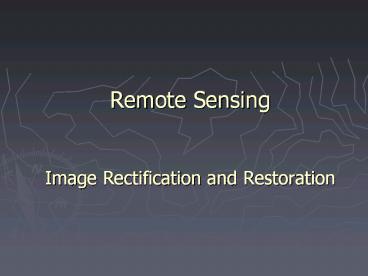Remote Sensing Image Rectification and Restoration - PowerPoint PPT Presentation
Title:
Remote Sensing Image Rectification and Restoration
Description:
Tahoma Arial Wingdings Symbol Compass 1_Compass Remote Sensing Image Rectification and Restoration Image Rectification and Restoration 1. Geometric ... – PowerPoint PPT presentation
Number of Views:256
Avg rating:3.0/5.0
Title: Remote Sensing Image Rectification and Restoration
1
Remote Sensing Image Rectification and
Restoration
2
Image Rectification and Restoration
- Geometric correction
- Radiometric correction
- Geometric restoration
3
1. Geometric Correction
- For raw image rectification
- For multi-date images registration
- For multi-resolution images or data layers
registration - Systematic distortion vs. random distortion
4
Skew Correction
Coordinate transfer Pixel value resampling
http//rst.gsfc.nasa.gov/Intro/Part2_15.html
5
(No Transcript)
6
Ground Control Points (GCP)
- Features with known locations on a map (X,Y
coordinates). These are the ground control
points - The same features can be accurately located on
the images as well (column, row numbers) - The features must be well distributed on the map
and the image - Highway intersections are commonly used ground
control points
7
Finding UTM coordinates on a map
8
Coordinate Transform
- Coordinate transform equations relate
geometrically correct map coordinates to the
distorted image coordinates - x a0 a1X a2Y
- y b0 b1X b2Y
- x,y column, row number
- X,Y coordinates
- Root Mean Square Error (RMSE)
- v(dx)2 (dy)2
- Calculate RMSE for all control points
9
Resampling
- The purpose is to assign pixel values to the
empty pixels in the rectified matrix output - Superimpose the rectified output matrix to the
distorted image - The digital number (DN) of a pixel in the output
matrix is assigned based on the DN of its
surrounding pixels in the distorted image
10
Re-sampling Methods
- Nearest neighbor resampling
- Bilinear interpolation
- Cubic convolution resampling
11
Nearest Neighbor Resampling
- The DN of a pixel in the output matrix is
assigned as the DN of the closest pixel in the
distorted image - Advantages
- simple computation
- maintain the original values
- Disadvantage
- spatial offset up to 1/2 pixel
12
(No Transcript)
13
Bi-linear Interpolation
- Distance-weighted average of DN values of the
closest 4 pixels - Advantage
- output image is smoother than the nearest
neighbor method - Disadvantage
- alters the original DN values
14
Cubic Convolution Resampling
- Uses DN values of the closest 16 pixels,
adjusted by distance - Advantage
- smooth output image
- Disadvantage
- alters the original DN values
15
(No Transcript)
16
When to Rectify
- Rectify before image classification
- Rectify after image classification
17
2. Radiometric Corrections
- Radiometric responses differ by
- dates
- sensor types
- images
- Causes
- - Illumination
- - Atmospheric conditions
- - View angle or geometry
- - Instrument response
18
Radiometric Corrections
- Sun elevation correction
- Atmospheric correction
- Conversion to absolute radiance
19
Sun Elevation Correction
- DN
- --------------------------------
- Sin (Sun elevation angle)
- Assuming the terrain is flat
20
(No Transcript)
21
Atmospheric Correction
- Haze compensation
- The DN value of an object (e.g., a deep clear
water body) with 0 reflectance Lp - Subtract the DN from the entire band
22
Absolute Irradiance
- Conversion of DN values to absolute radiance
values - It is necessary when compare different sensors,
or relate ground measurements to image data - L (Lmax- Lmin)/255 DN Lmin
23
3. Geometric Restoration
- Stripping
- Line-drop
- Bit errors
24
Striping
- Malfunction of a detector
- Use gray scale adjustment to correct the strips
25
Line Drop
- using average of the above and below lines to
fill the dropped line
26
Bit Error
- Salt and pepper effect due to random error
- Use 3x3 or 5x5 moving window average to remove
the noise
27
Readings
- Chapter 7
28
Earth-Sun Distance Correction
- E0 Cosq0
- E ------------
- d2
- Irradiance is inversely related to the square of
the earth-sun distance - E - normalized solar irradiance
- E0 - solar irradiance at the mean Earth-sun
distance - q0 - sun angle from the zenith
- d - Earth-sun distance
29
Atmospheric Correction
- rET
- Ltot --------- Lp
- p
- r - reflection of target
- E - irradiance on the target
- T - transmission of atmosphere
- Lp - scattered path radiation

